South Australia’s Liberal government officially opened the country’s biggest support scheme for household battery storage, with up to 40,000 homes able to access grants and low-interest finance for both battery storage and new rooftop solar installations.
The $200 million scheme – half in grants and the other half in loans provided by the Clean Energy Finance Corporation – delivers on a pre-election promise from the newly elected Marshall government, but is heavily modified after the then Labor government proposed a similar scheme, but with more focus on low-income housing and more connection between installations.
South Australia – as most people are aware – is leading the country and possible the world in terms of penetration of wind and solar, with more than 50 per cent of its generation coming from these variable resources, and the Australian Energy Market Operator predicts that share could rise to near 100 per cent by 2025.
While much of the focus has been on the state’s large-scale renewable investments, the state also boasts the highest penetration of rooftop solar, with more than 930MW, and this is starting to have an impact on the way the grid is managed.
Last Sunday, the widespread adoption of rooftop solar pushed grid demand down to yet another record low of 594MW – a fact acknowledged by the Australian Energy Market Operator in its own report.
Rooftop solar is now providing up to 45 per cent of generation at certain times of the day, and the growing amounts of solar could push that grid demand to zero in coming years, causing AEMO to look for ways to try and “orchestrate” this resource for the overall benefit of the grid.
The scheme could add up to 400MWh of storage to the grid – not quite four times the size of the 100MW/129MWh Tesla big battery next to the Hornsdale wind farm that has dominated interest from operators and market players – and this could time shift the output of solar, and provide essential grid services.
South Australia’s minister for energy and mining Dan van Holst Pellekaan says the scheme will benefit all South Australians, because it will add to grid security.
“Not only will up to 40,000 households enjoy reduced electricity prices by purchasing a home battery system, but the installation of these systems will reduce demand on the network,” van Holst Pellekaan said in a statement.
“This will ultimately result in lower prices for all South Australian households”.
Premier Steve Marshall also talked up the investment and job benefits from the scheme, with German battery storage maker Sonnen due to start manufacturing (assembling) batteries at the old GM car plant in Elisabeth in November, with some 400 jobs.
Sonnen had indicated its intention to do so with the previous Labor government, and made its final commitment after the new government committed to its scheme, and promised priority for locally made equipment. It plans to make deliver 10,000 batteries a year from the Adelaide operations.
Sonnen batteries are available from today, and other battery storage makers will be available after a nine week period.
 The battery storage grant scheme is offering grants on a scaled basis, of $600/kWh for concession card holders and $500/kWh for all others. Up to $6,000 can be granted to a 10kWh battery, and $3,000 for a 5kWh battery.
The battery storage grant scheme is offering grants on a scaled basis, of $600/kWh for concession card holders and $500/kWh for all others. Up to $6,000 can be granted to a 10kWh battery, and $3,000 for a 5kWh battery.
The amount of subsidy is also expected to reduce quickly as prices of battery storage fall as the market takes hold, and will need to: the $100 million of grant funding allocated is not nearly enough money for 40,000 households at this price.
“We are creating jobs and attracting new business to our state by giving priority to qualified system providers who commit to installing approved battery systems that are manufactured or assembled in South Australia,” Marshall said. These providers will be afforded a nine-week priority period meaning their products will be exclusively available to households.
Several other battery storage scheme are also going ahead in South Australia, mostly focused on using the devices to create “virtual power plants” that can deliver grid services and help marshall resources to meet peak demand.
Tesla is installation 1,100 battery storage installations as part of the first two stages of a proposed 250MW VPP unveiled by the previous Labor government. It is unclear yet whether the final stage of nearly 50,000 homes will go ahead now that the new scheme has been unveiled.
AGL is also working on a separate VPP, using Solar Edge, LG and Tesla as its preferred suppliers, although the future of this scheme is not clear given that the company’s New Energy division has been disbanded.
Victoria has also added a battery storage component in the lead up to next month’s state elections, although its focus is still heavily in favour of rooftop solar, with plans to encourage another 650,000 homes add 2.6GW of rooftop solar over the next decade.
The CEFC low-interest loans and the grants and the grants will be administered by Australian lending company RateSetter. So far, 12 different providers have been authorised.
“Home battery solutions, which help householders get more out of their rooftop solar PV, can help cut energy costs and reduce carbon emissions – making both good economic and environmental sense,” CEFC CEO Ian Learmonth said in a statement.
More information on the Home Battery Scheme is available at www.homebatteryscheme.sa.gov.au or call 8463 3555. Businesses interested in becoming system providers can do so at www.homebatteryscheme.sa.gov.au/become-a-provider










